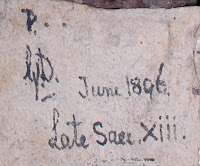George Dunn's books are usually easy to recognise: they typically contain a book-label as follows:
On the facing flyleaf there are sometimes bibliographical comments, and almost always an acquisition-note consisting of a price-code, his initials "G.D.", and the date:
| λρη | G.D. | Oct. 1907 |
The first sale of Dunn's library took place in 1913, and the Harvard Law School bought a large group en bloc. These have been digitised, so it is possible to look at a significant number of Dunn inscriptions rather easily. From this it appears that Dunn used the entire alphabet, α β γ δ ε ζ η θ ι κ λ μ ν ξ ο π ρ ς σ τ υ φ χ ψ ω, or nearly so.
Below I will group images of codes into groups, and follow them with some additional clues to decipherment. The most typical code consists of three letters with a short dash to each side:









Sometimes there are just two Greek letters, preceded and/or followed by dashes:














What should make the code easier to crack is a number of books for which we know his purchase-price, and can see what the encoded version is, but the few examples I have gathered are confusing.
At the sale of the library of Sir Henry Hope Edwards at Christie’s on 20 May 1901, Dunn bought three manuscripts, now British Library, Add. MSS. 38662, 38663, and 38664, all of which are available online. We therefore have both the auction-price and Dunn's coded cost, as follows:








Classical Greek had an alphabetical system of numbers (alpha =1, omega=800, etc.) but these price codes don't make sense using it.
ReplyDelete